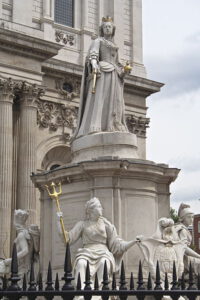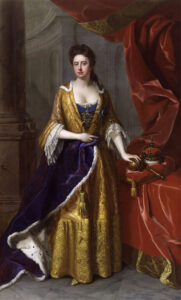Anne
*02/1665
†08/1714
Parents
Father: James VII/II.
Mother: Anne Hayde
Marriage
Prinz George of Denmark
Children
2 Sons
3 Daughters
10 Stillbirths
2 Misscarriage
Coronation
04/1702 in Westminster Abbey
Regency
03/1702 to 1707 Scotland, England and Ireland
1707 to 1714 Great Britain
Anne was with her Sister Mary, one of two Children who reached Adulthood.
From the beginning she suffered from a serious Eye Disease, so she spent the first years of medical care in France with her Grandmother Henrietta Maia de Bourbon, later with her Aunt Henrietta Anne Stuart.


In 1670 Anne returned to England. Three years later, she met Sarah Jennings (later Churchill), with whom she had a very good Friendship, so that she became her main adviser over the years. After 1672 it became known that her Father James VII./II. converted to Catholicism, she and her Sister were still educated protestant on the instructions of her Uncle Charles II. He also arranged her Marriage with the Protestant George of Denmark in 1683.
When her Father ascended the throne in 1685, he had much in mind for a catholic Succession and promised Anne the Throne if she would profess Catholicism. Anne, however, stuck to her anglican Beliefs.
Eventually, her Sister Mary and her Husband William joined the Throne, and Anne, influenced by Sarah Churchill, agreed that William should continue to hold power after Mary’s Death, and that she would then take over the Throne. In the course of 1689, the Relationship with her Sister, which had been so good up to now, began to deteriorate. Anne wanted to secure her Income and, without Mary’s knowledge, made an Agreement with the Parliament, which gave her an annual payment of £ 50,000.

In 1691 the Break between the Siblings began.
After the Achievements of Anne’s Husband George were not appreciated during the Irish Campaign, he was denied service in the Navy. The following year, John Churchill, Earl of Marlborough -the Husband of her Friend Sarah- was accused of involvement in a Plot to restore James to the Throne and therefore, dismissed all of his Posts and expelled the Court. In addition, Mary demanded of her Sister to dismiss Sahra from her service when Anne appeared with her at the Court three weeks later.
Anne refused and there was a final Break. Despite everything, she wanted to see her Sister again, as this was 1694 on his Deathbed, but was rejected by William, because the risk of infection. In the Aftermath William tried to improve the Relationship with Anne again and set 1695 Churchill again in all offices.

By the year 1700 Anne and George had to take some personal low blows.
Until then Anne had had 13 Miscarriages and Stillbirths. Of the remaining five live births, four died before their second Birthday. The last Child died of a smallpox infection at the age of 11 years. Anne would have preferred a succession to the Throne by descendants of her Father James, in the need for a protestant Succession, she found in 1701 but with the adopted by Parliament ‘Act of Settlement’ from. Accordingly, the succession to the Throne after Anne’s Death on Sophie of the Palatinate -Sophie was the Daughter of Elisabeth Stuart a descendant of James VI./I.- and their descendants transferred, since the other aspirants were all Catholic.
After the Death of William, Anne was, as established by Parliament in the ‘Bill of Rights’ 1689, heir to the Throne.
Due to numerous Pregnancies and Gout, she was physically a “Cripple” and was carried in a Litter for Coronation in April 1702. Shortly after her Enthronement, which took place in March, she appointed her Husband Lord High Admiral and handed over John Churchill -Churchill also received several Honors, including the Order of the Garter- leading the Army, and elevated him to the Duke of Marlborough. Her longtime girlfriend Sarah Churchill named her Mistress oft the Robes.
The first years under Anne, in addition to the spanish War of Inheritance, which began almost simultaneously with her Coronation, were marked by her attempts to unify the english and scottish Kingdoms.
The adopted ‘Act of Settlement’ was not discussed with the scottish Parliament, which wanted a successor from the House Stuart. As a Result, the Scots adopted the ‘Act of Security’, according to which, should the Queen die without descendants, she could elect her own Monarch, provided that he is of Protestant and royal descent. They threatened to deduct their Part of the Army and raise no Taxes, Anne agreed after initial refusal. However, the english Parliament feared that an independent Scotland would revive the ‘Auld Alliance’ with France and in 1705 issued the ‘Alien Act’. It allowed Scotland to impose considerable restrictions on Scotland, declare Scots foreigners, and thereby restrict their right to Ownership´s in England. The English Parliament made it clear that if Scotland did not revoke the Security Law or unite with England, these measures would be implemented.
In July 1706, scottish Envoys agreed to an association and the scottish Parliament approved this decision in January 1707, while the majority of the scottish People rejected it.
As of May 1707, Anne was Queen over Great Britain and Ireland!
In the following years it came because of the spanish War of Succession and different power claims of the Parties to upheavals in the english Parliament. With the Peace of Utrecht in 1713 Britain’s Participation in the War of Succession ended.
Phillip V., a Grandson of Louis XIV., remained on the Throne of Spain and retained much of the Colonies, while the remaining sphere of influence of Spain was divided. Britain was awarded Gibraltar, Menorca and some of the French colonies in North America. Amongst them Annes catholic Half-Brother James Francis Edward Stuart (The Old Pretender) -a Son James II.- repeatedly took initiatives to take the Throne. Every time Anne was ill, London’s Coffeehouses speculated on how far he was preparing to land on the british Isles and start a Civil War, while Anne did not show much Support for Sophie of Palatinate, which since the Act of Settlement the predetermined heir apparent was and refused Visits from her or her Son.
Sophie died in June 1714 and barely two months later, Anne became seriously ill.
Just before she fell into a Coma at the end of July, Anne appointed a new Head of Government under the urging of her Governing Councilors. In the meantime, the followers of the Whig Party, committed to the succession Law and the Nation’s commitment to Protestantism, were preparing to take up arms. The Council also made its preparations.
“Effective measures were taken to secure Hanoverian Succession. Messengers were sent in all directions to summon every Officer and Offical to his Post. The Fleet was mobilized under the command of a Whig, the Earl of Berkeley, and was ordered to patrol the British Channel and watch the french Ports. Ten Battalions were recalled from Flanders. The Garrisons were armed and the militia alerted. The Dutch were reminded of their contractual obligations. Everything was ready to secure the accession of the Elector of Hanover as George. […] When Queen Anne made her last breath on August 1 at half past seven, it was clear that there would be no papism, no controversial succession, no French bayonets and no civil war. ”
Winston Churchill, British Prime Minister and descendant of Sarah Churchill

The late Queen was buried in Westminster Abbey at night.
While no Grave Monument commemorates Good Queen Anne today, the white marble memorial still stands erected by her long time confidant Sarah Churchill at Blenheim Palace.
By the Act of Union, which united the Kingdoms in May 1707, Scotland was no longer an independent Kingdom.
The Personal Union became a Real Union, which still exists today, while Ireland continued to remain in Personal Union with Great Britain. After a bloody Civil War (1919-21), Ireland was granted Dominion Status. This allowed for political Independence and the founding of the irish Free State, with six Counties of the Province of Ulster (Northern Ireland) remaining part of the United Kingdom. Even when Ireland emerged from the Commonwealth in 1949, the Counties remained Part of the Kingdom.
